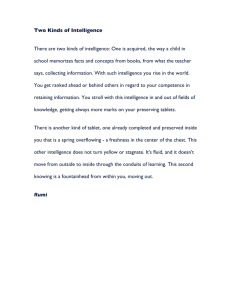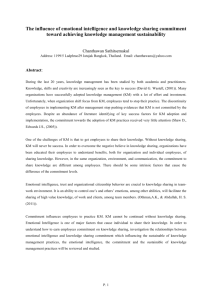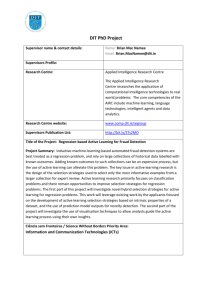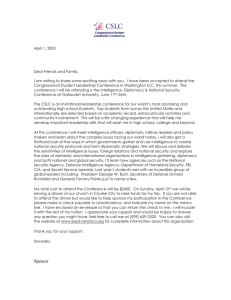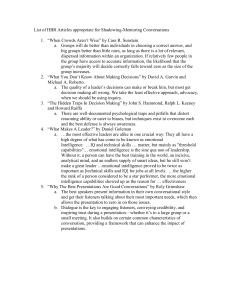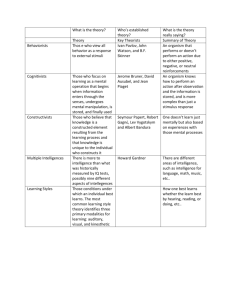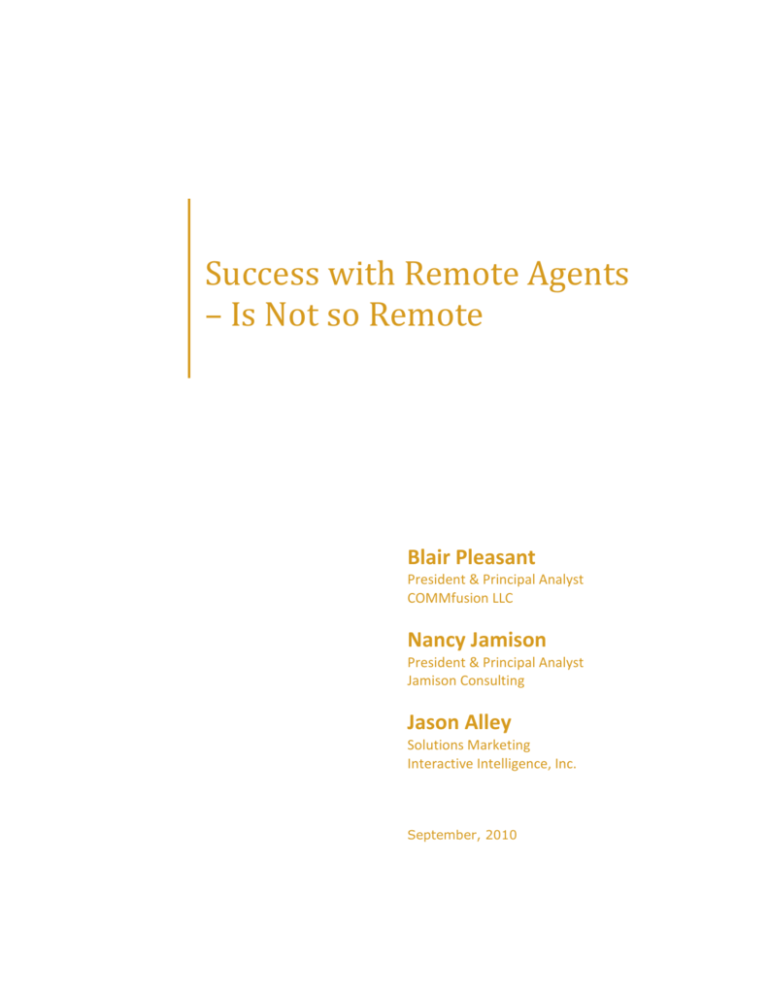
Success with Remote Agents
– Is Not so Remote
Blair Pleasant
President & Principal Analyst
COMMfusion LLC
Nancy Jamison
President & Principal Analyst
Jamison Consulting
Jason Alley
Solutions Marketing
Interactive Intelligence, Inc.
September, 2010
Table of Contents
Introduction ........................................................................................................................ 3
Will Using Remote Agents Benefit Your Business? ............................................................. 4
Going Remote is Not without Challenges ........................................................................... 5
Remote Agent Best Practices .............................................................................................. 8
Technology Best Practices ............................................................................................... 8
People Best Practices ....................................................................................................... 9
Process Best Practices .................................................................................................... 10
The Social Media Boom – Friending and Tweeting........................................................... 10
Social Media to the Rescue ............................................................................................ 11
Have We Convinced You? ................................................................................................. 12
Case Studies ...................................................................................................................... 13
RDI Marketing Services .................................................................................................. 13
VIPdesk .......................................................................................................................... 14
Copyright © 2010 Interactive Intelligence, Inc. All rights reserved.
Brand and product names referred to in this document are the trademarks or
registered trademarks of their respective companies.
Interactive Intelligence Inc.
7601 Interactive Way
Indianapolis, Indiana 46278
Telephone/Fax (317) 872-3000
www.ININ.com
Publish date 09/10, version 1
© Interactive Intelligence, Inc.
2
Success with Remote Agents – Is Not so Remote
Introduction
iPhones, BlackBerrys, Facebook, Twitter, and other media channels — they’ve not just
changed how we communicate, but also our expectations for customer service and
support, as they have made businesses ultimately accessible. As a result, consumers
now expect to get the information they want, when they want it, regardless of time of
day, day of week, or how they’re connecting with a company, forcing companies to be
flexible and innovative, finding new ways to provide optimal 24x7 customer service
while still keeping costs down. One way of accomplishing this is through the use of
remote agents — contact center agents that work remotely from their home or in a
branch office or other remote location.
Technology has evolved to enable any company, of any size, anywhere, to utilize remote
agents — with as little as a high-speed Internet connection, a computer, a phone, and a
quiet environment. There are many ways to offer remote agent capabilities, but the
most effective is a centralized all-in-one IP communications system that can be
implemented on-premise or through a hosted offering (also known as Communications
as a Service, or CaaS). These systems make it easy for IT staff to provide agents with
access to the technology capabilities they need, regardless of location. Whether it’s a
phone call, an email, a fax, a web chat, or a social media inquiry, all customer
interactions can be handled by agents located in a pre-qualified location — typically a
main office, remote office or home office.
Virtual All-in-One IP Communications
Source: Interactive Intelligence, 2010
© Interactive Intelligence, Inc.
3
Success with Remote Agents – Is Not so Remote
These all-in-one IP communications systems also provide tools for supervisors and
managers to effectively manage remote agents — just as if they were in the office —
and mechanisms for customers, agents, supervisors and subject matter experts to
communicate seamlessly across multiple channels.
This paper provides new insights to help you weigh the option of using remote agents,
discusses best practices, and takes a look at new agent capabilities that are impacting
the remote agent model. In addition, it includes detailed case studies of companies that
have successfully deployed remote agents.
Will Using Remote Agents Benefit Your Business?
The use of remote agents is not for everyone, but it’s well worth investigating their use
to augment a contact center. However, as one Director of Technology advised, “Don’t
deploy remote agents for remote sake — there has to be a strong business driver. If you
don’t have a problem that remote agents will solve, don’t do it.”
Some of the more striking benefits include:
Increased agent talent pool – By using remote agents, organizations can take
advantage of a variety of workers that may not be able to work full-time in a
formal contact center. Remote agent deployments can include work-at-home
(WAH) parents, students, disabled workers, retirees, and others. For example,
Veterans2Work specializes in matching veterans with companies and
opportunities designed to allow them to work from home, providing customer
or technical support services. Organizations can recruit and attract talent
globally as well, including people living in small towns or remote locations. This
allows access to people with hard-to-find skillsets that are not able to commute
to the company’s facility. Many potential workers cannot afford the time and
expense to travel to a contact center facility and working remotely lets them be
productive from home.
Reduced churn – Agent attrition is something every contact center is concerned
with. Running at approximately 10% per month in North America,
internationally the issue is much more serious. According to Dr. Catriona
Wallace, Managing Director at analyst organization callcentres.net, Australia has
seen agent turnover of 49%, and India has experienced roughly 60-70%
attrition. According to Rod Jones, Contact Center Industry Specialist at Contact
Centre Strategic Solutions, the average tenure of agents in South Africa is 14-21
months. Adding remote agents has provided an answer to this challenge,
enabling companies to better retain educated and motivated workers. Contact
center managers have reported that agents who work at home are generally
more satisfied with their jobs and appreciate the flexibility of being able to work
remotely, in work shifts that fit in with other responsibilities. For example, the
deployment of remote agents has reduced the attrition rate at one company
from 25% to 5%.
© Interactive Intelligence, Inc.
4
Success with Remote Agents – Is Not so Remote
Better results – Catriona’s research shows that agents are often more
productive working remotely than in a formal contact center environment,
noting that Salmat, an Australian-based outsourcer of multichannel customer
communication, experienced a significant increase in agent engagement and
productivity after moving over 400 of its agent workforce to the home — many
living in regional Australia.
Cost savings – By using remote and at-home workers, companies can avoid
building new contact center facilities, and can even rent out space in their
buildings that would have been used for contact center agents. For example,
one company we spoke with now sublets part of its office space, helping to cut
costs, and has seen large cost savings in the area of new hire training as attrition
rates improved dramatically.
Flexibility and ability to meet peaks and ebbs in demand – By having the option
of bringing remote or home-based workers online quickly, companies can better
respond to changing demand on a daily or seasonal basis, or in an emergency,
and manage peaks and valleys in call loads, without hiring for peak hours.
Business continuity – Employing remote agents allows companies to be nimble
and responsive in keeping the business going in the face of a natural disaster, or
other crisis. When a crisis does occur, calls can be quickly routed to agents that
are available remotely.
Going green – At-home workers avoid commuting, thus reducing their carbon
footprint. This saves money for the worker, while helping the environment.
Companies avoid having to expand facilities as their contact center operations
grow, avoiding the added energy burden of a larger contact center.
Follow-the-sun support – Deploying remote agents in various parts of the world
and in different time zones can help support an organization’s follow-the-sun
strategy, providing customer service and support regardless of time-of-day or
day-of-week. Many workers are willing to work from home at night and on
weekends, so coverage can be expanded without even leaving the time zone.
Think globally, act locally – Global companies that want to have local agents
interact with customers, but cannot afford to build or staff contact centers in
each region where they operate, can use remote agents to serve an international
customer base without having to make a huge or unnecessary investment.
Going Remote is Not without Challenges
Employing remote agents has both real and perceived challenges. The following are the
three greatest perceptive barriers for uptake:
Perceived loss of control – Many senior executives don’t feel agents can be
trusted to work at home without constant in-person supervision. Are at-home
and at office environments really that different? Sally Hurley, President of
VIPdesk, explains, “Most managers in centralized contact centers don’t
physically look around the room to see who is on the phone, they use software
to determine agent usage and performance. The same is true for a virtual
operation. We rely on technology dashboards to monitor schedule adherence,
© Interactive Intelligence, Inc.
5
Success with Remote Agents – Is Not so Remote
utilization and overall performance. As such, we are using the same
management tools.” To overcome the control issue, some companies require
agents to work a shift in the office once a month so they can have face time
with their supervisors.
Perceived security compromise – Many senior executives quiver at the idea of
allowing remote agents to access sensitive data remotely. The reality is that
whether or not an agent is in the office has little to do with their propensity to
handle customer information inappropriately or fail to follow proper security
procedures. Customers that adopt the remote agent model typically lock down
a designated computer for company use only and/or provide a thin terminal
client, in addition to taking necessary network security precautions to ensure
secure, encrypted communication. This is one of those issues few want to argue
with and assume the risk for, but most know has been addressed for years.
Lack of awareness of adoption – Surprisingly, much of the market is unaware of
the progress that has been made with remote agents. We strongly recommend
getting senior executives in front of real customers solving real problems. An
“aha!” moment will likely follow.
Negative perceptions are often difficult to overcome, but the hard work with executives is
mostly up-front. Catriona Wallace notes that once senior executives “get it,” a mandate to
rapidly deploy the model across a significant portion of the agent pool generally follows.
She noted that after initial use of remote agents, Westpac Bank in Australia mandated
that 15-20% of the agent workforce work from home in the next 12 months.
Once approval to move forward with the remote agent model is received, there are
other challenges that may need addressing, including:
Initial set-up and adjustment – Jim Borum, Senior Vice President at RDI
Marketing Services, shares, “Coordinating the initial set-up and getting agents
adjusted can be a challenge. This includes
making sure the agent’s home connection
Make sure the remote
works, they adjust to their new work
agent’s home connection
environment, and family members are
works...
trained on how to behave while work is
that they adjust to their
in progress at home.”
new work environment...
Agent isolation – One of the greatest
and that family members
challenges is that agents working remotely
know how to behave
can often feel isolated. In fact, some have
while work is in progress.
chosen to come back into the contact center
because working at home just doesn’t suit
them. Adjusting to this new environment can be a particular challenge for an
older, more mature workforce. Sally Hurley at VIPdesk notes, “Due to the
distributed nature of our employees, team members don’t often meet face-toface.” To combat this, VIPdesk uses social media tools, such as chat rooms —
both social (for “water cooler” discussions) and campaign specific — to keep
agents engaged and connected. In the absence of face-to-face interaction,
© Interactive Intelligence, Inc.
6
Success with Remote Agents – Is Not so Remote
VIPdesk also holds regular “town hall” webcasts, and regular scheduled team
meetings via conference call. In addition, chat rooms and instant messenger
tools have features that allow VIPdesk agents to see their colleagues’ photos
and presence status, helping to keep them connected. RDI also uses chat
extensively to help remote agents feel connected and to enable them to reach
back into the contact center to access knowledge experts.
Training – Remote agents don’t have the benefit of sitting in a classroom unless
they come into the main facility, but with the proper use of online and virtual
training, this can be a non-issue. VIPdesk, for example, provides 100%
instructor-led training in small virtual classrooms of no larger than 12-15
students, along with requisite online training and reading material, online
assessments, and chat rooms to discuss training issues. Some companies prefer
to have the agents trained in their facility prior to beginning work remotely.
Which approach to take — online, virtual, in-person or a mix — really depends
on the business, and agent type.
Sorting through the applicants –
“Our biggest challenge is
Ironically, companies that move to a
being a matchmaker for the
work-at-home model often find
brands we represent and the
themselves with a problem they really
10,000+ applicants we
didn’t anticipate — how to manage all
interview every month.”
of the requests for employment. This is
Sally Hurley,
a good problem to have.
President, VIPdesk
Outside of North America, there are other unique challenges, including:
Broadband Access –Some Asian countries such as China, India, and Malaysia
contend with reliability issues and availability of the communications
infrastructure and broadband access, limiting the locations remote agents can
work from. This has been a major issue in South Africa as well. However,
progress is being made that will soon remove this barrier in many international
locales. Rod Jones explains, “We are very excited about mammoth rollouts of
bandwidth in South Africa. Local deployment and availability of bandwidth is
growing daily.”
Government, political and union issues – There are still significant government
and political issues to overcome to increase adoption, especially in Asia. Unions
can be extremely powerful and are not always supportive of the work-at-home
model. The resistance is ironic given the opportunity to enhance the economy
during difficult times.
Theft and violence – There are certain regions that just aren’t safe to have
remote agents deployed. Crime can be a serious inhibitor as having expensive
equipment in such areas could present a risk to the company and, more
importantly, the agent. Rod Jones shared that there is also a major copper theft
problem in some areas of South Africa – a phenomenon that has been on the
rise across the globe during the economic downturn.
© Interactive Intelligence, Inc.
7
Success with Remote Agents – Is Not so Remote
Overall, however, those who have deployed remote agents successfully have found that
the benefits far outweigh the challenges. With that said, let’s take a look at a few best
practices for deploying remote agents.
Remote Agent Best Practices
As with any new implementation, there are best practices that organizations should
follow when deploying remote agents, keeping the focus on technology, people, and
process. An important part of the process is to remain flexible. Whether your goal is to
take advantage of a larger labor pool, or to save costs, remember that working remotely
may not be for everyone, while for some it is considered an attractive benefit. With that
in mind, here are some best practices for utilizing remote agents.
Technology Best Practices
Remote agent capabilities should be inherent in a contact center platform, rather than
as an add-on. In fact, if warranted, the physical location of the agent doesn’t have to be
constrained to the home, as long as proper rules (such as quiet environment) are
adhered to. A centralized all-in-one IP communications system can satisfy this need and
be implemented on-premise or through a hosted (CaaS) offering. It is important to have
the flexibility to migrate between on-premise and hosted environments to address
changing business conditions. For example, in the event of hard financial times or
natural disaster, being able to switch to a hosted solution to cut costs or overcome
location challenges can be of real benefit.
Workforce optimization software — quality monitoring, workforce management,
performance management and analytics — becomes even more critical in a remote
agent operation. Thus, it’s important to make sure your contact center platform is
equipped to support these capabilities. Most companies are already heading in this
direction as they look to virtualize contact center operations, some on a global basis.
Where appropriate, combine a traditional contact center with work-at-home agents and
automated self-service systems. Calls and interactions can be handled from the main
contact center during regular business hours, supplemented by self-service systems (IVR)
and remote workers for nights and weekends. Also, be sure to set-up pre-built scripts
that can be invoked quickly to enable agents to take calls at home when disaster strikes.
Remote agent access and endpoints should be flexible to meet the needs of the business
and agent, providing access to all the same applications and tools onsite agents use.
Secure access should be anywhere/anytime through a web client and endpoint of choice
(home phone, cell phone, remote office phone, etc.) or mirror an office environment
through a broadband connection, VPN and SIP endpoint (IP phone or softphone).
Terminal server access utilities provided by companies such as Citrix can be used to
provide secure access, as well as simplify deployment for IT.
Looking ahead, remote agents should be capable of leveraging full unified
communications (UC) feature sets supported by their organizations in support of a
broader UC strategy. For example, agents should be able to conference in, and even
collaborate and share documents on the web with supervisors or subject matter
© Interactive Intelligence, Inc.
8
Success with Remote Agents – Is Not so Remote
experts. Additionally, the chat function of UC can be leveraged to enable interaction
with supervisors or other agents on a customer issue without interrupting the call. The
growing use of UC in the contact center is also illustrated with the use of expert agents.
As with any business and technology decision, return on investment (ROI) is crucial.
Identify the costs with the technology that is needed, and determine the ROI of using
remote agents. This includes identifying the costs your company will absorb, versus
what the remote agent is responsible for. Some companies provide the computer,
telephone or end-point device, high-speed Internet access, and other things, while
others expect the agent to provide them.
People Best Practices
In order to carefully select the right agents that can work independently, are reliable
and self-disciplined, and will treat customer information confidentially, competencybased staff screening and assessments are necessary, in addition to extensive
background testing. Screen workers for the skills and capabilities needed, as well as
their personality. Gregarious, social people may not be the ideal candidates, if part of
their make-up is being near co-workers, for example.
Next, establish a probationary trial period in order to determine whether each new-hire
is a fit for working remotely. Determine performance metrics to measure the success of
your remote agents. Metrics may include customer satisfaction, speed of answer,
dropped calls, quality scores, productivity scores, and agent retention or turnover. Be
sure to communicate expectations clearly and make appropriate performance data
available to agents so they can self-manage to expectations.
Be flexible. Allow for a breaking-in period, and if working at home doesn’t work out for
the employee, they should be able to return to the contact center facility without loss of
status. Have clear guidelines for agents as to what is expected of them, including having
a separate work area dedicated solely to their job in a quiet environment — no barking
dogs or crying babies — no interruptions from family members, etc. Some companies
have their remote agents sign a work agreement up-front, with zero tolerance policy for
noise and unprofessional behavior. A common best practice is to treat the ability to
work at home as a privilege or a reward, rather than a right, based on satisfactory
performance, and to schedule remote workers based on their performance, so that the
plum weekday daytime hours go to the best performers.
Training can make or break a remote agent strategy. Depending on the complexity and
sophistication of the issues and types of interactions agents will handle, companies may
require initial agent training to take place in the company’s contact center or main
facility, with follow-up training taking place online. Regardless of which route you take
for the initial training, it’s important to provide ongoing online training for agents,
allowing them to access training sessions at their convenience. E-learning and webbased training makes it easier for remote agents to be trained, and workforce
optimization products and services make it easy for remote agents’ performance to be
monitored remotely, while having the same recording, reporting and analytics
capabilities as in the formal call center.
© Interactive Intelligence, Inc.
9
Success with Remote Agents – Is Not so Remote
Process Best Practices
The most obvious best process practice is to provide remote agents with the tools and
resources they need to properly do their jobs. The same advanced contact center
management tools and resources that are available to formal contact center agents
MUST be provided to remote agents. This includes computer telephony integration and
access to customer history and information in order to best service the customer, access
to knowledge databases, and other resources available to brick-and-mortar based
agents. Without these tools, remote agents may not be able to solve the customers’
issues, resulting in customer dissatisfaction, and potentially lost revenue. Also be sure to
provide remote agents with the appropriate levels of authority and access to do their
jobs. There is nothing more frustrating to customers than interacting with an agent who
can’t solve their problem because they don’t have the authority or access to do so.
Similarly, contact center managers and supervisors must have visibility to the remote
agent, with the same reporting, recording, monitoring, staffing, and workforce
optimization capabilities extended to remote agents. Reporting, recording and
monitoring are critical in ensuring quality control of remote workers, and help overcome
some of the objections to using remote agents. Tools to ensure information security and
confidentiality are required, guaranteeing that data is not leaked due to malware.
Recording 100% of the remote agents’ calls, plus the use of analytics to identify issues
and trends, as well as after-call customer surveys, helps to ensure that the expected
quality and performance is being met.
Additionally, communications between remote agents, their supervisors, managers and
subject matter experts is even more important than for in-house agents. Establish a
formal communication process between agents and supervisors, and put in place any
tools to help facilitate ongoing contact. For example, UC tools such as chat and video
conferencing can help remote agents feel connected and less isolated, and allow the
supervisors better visibility into how their remote workers are doing.
Finally, reward at-home or remote agents in the same way with the same visibility as inhouse agents. Where possible, enable remote workers to take part in any company
festivities, either by giving enough notice for them to join, or set up something remotely
with other remote workers.
The Social Media Boom – Friending and Tweeting
Do you tweet? The most exciting recent addition to the contact center is the use of
social media (or social software) sites such as Twitter and Facebook as customer service
channels. More and more people are turning to these sites in order to bypass calling or
sending an email to a company, in hopes of getting faster, more personalized service.
Rather than looking for the customer support phone number, going through an IVR
menu, and waiting on hold for a live agent, more and more customers are utilizing social
media for fast responses to relatively simple problems. Getting attention from a
company can be as simple as going to their Facebook page, or sending a “tweet” to their
Twitter address.
© Interactive Intelligence, Inc.
10
Success with Remote Agents – Is Not so Remote
According to various industry experts, less than 10% of contact centers currently
integrate social media. However, the number of companies using Twitter and Facebook,
and other social software services to interact with customers and provide customer
service is increasing. Companies such as Comcast, Dell, JetBlue, and Zappos are leading
the charge. Many are beginning to recognize that they can use social media channels to
engage with customers, resolve customer problems and issues, get feedback, and build
goodwill for their brands. For this scenario, remote agents are ideal — provided they
have the tools and resources needed to best serve customers. The Internet never
sleeps, and remote social media agents can provide service 24 hours a day, from any
location.
Social media outlets can be flexibly integrated into
Remote agents can be an
a multi-channel contact center. Some companies
effective way of staffing
may choose to use dedicated agents for social
for a contact center’s
media interactions, while others opt for blended
social media channel.
agents. For example, a company can use agents to
monitor chatter, or calls can be routed to agents
after they are mined from social media chatter, and agents can respond accordingly. For
companies turning to social media for customer service and customer interaction, the
use of remote agents can be an effective way of staffing for this new channel.
Social Media to the Rescue
One of the most enticing aspects of this emerging channel is that it can also benefit the
remote agent. Social media tools can help overcome one of the biggest challenges to
the use of remote agents — the lack of communication between agents and supervisors,
and the isolation agents experience when they are not in the main contact center
facility. Often times the agents are unable to interact with other employees for social
purposes or to access information. With today’s unified communications and social
networking capabilities, this is no longer an issue.
As we have seen with companies such as RDI and VIPdesk, Instant Messaging (IM) and
live chat lets remote agents interact with their supervisors and managers, as well as
other contact center agents. Some companies use chat rooms for remote agents to
communicate with each another, as well as internal message boards and wikis for
agents to collaborate to solve problems and to share and have access to necessary
information to do their jobs effectively. UC and social media capabilities let remote
agents share information about their experiences and get immediate feedback from
their peers and supervisors. For supervisors and managers who like to hold meetings
and see their workers, inexpensive desktop video conferencing lets remote agents and
supervisors have more personal interactions.
Once again, Salmat developed an internal social media platform to let its 400 homebased agents interact via an online interactive community, including chat rooms,
forums, blogs, information bases, IM, and more. Agents use IM to get answers to
questions, and can interact with their supervisors via IM and chat, and even have social
interactions and games via the interactive community.
© Interactive Intelligence, Inc.
11
Success with Remote Agents – Is Not so Remote
Have We Convinced You?
The use of remote agents is growing — will you be part of this trend? If your company
deals with seasonal fluctuations, has locations across the globe, is looking for a way to
improve customer service while reigning in costs, and need to find and retain top
contact center talent, the answer should be yes. Using remote agents is an economical
way to be competitive, while providing employees with work-life balance alternatives
that benefit the environment and the bottom line.
© Interactive Intelligence, Inc.
12
Success with Remote Agents – Is Not so Remote
Case Studies
RDI Marketing Services
Excellence in Execution
http://www.rdioutsourcing.com
In business for over 30 years, RDI is a world-class outsourcer of contact center,
administrative services, and market research, across all verticals. Approximately 950 of
the 1,100 people in the company are agents, providing both inbound and outbound
services in customer care, sales and service, in four service centers, including a bilingual
facility in Arizona.
RDI’s remote agent model is a bit different than most. Of the 950 agents, about 5% work
at home, which is considered a perk. In most cases, agents have excelled at their work in
the contact center and were promoted and allowed to work from home.
What makes this work for RDI? Being able to promote the best people who have proven
themselves on the job and seem suited to work at home, into an at-home position.
Organizationally, these agents are treated the same as every other agent, and are
integrated individually into various campaigns as needed. Calls are routed to the agents
by skills, and the remote agents use the same tools as other agents, including chat and
presence capabilities to access and interact with supervisors and subject matter experts,
if needed. At-home agents are also monitored and managed exactly the same way as
other agents. RDI uses a model that lets the agent be close enough to the brick and
mortar center so they can visit the center if necessary.
To get started working remotely, agents are required to provide company-paid for
bandwidth, and receive a preprogrammed plug-and-play unit, cutting down on
complexity, and ensuring consistency in equipment. In order to assure data security, RDI
has employed a double security system for logging agents in remotely. RDI also insists
on a separate quiet work environment, with rules around outside distractions. 100% of
remote agent calls are recorded, which means the company can ensure that remote
agents adhere to the rules around a quiet environment. All training is done at the brick
and mortar facility, and to stay in touch, all agents are required to come in and work at
the contact center once a month.
Using remote workers has had many benefits for RDI, including a low attrition rate. For
example, RDI has found that in cases where they might have lost people who could no
longer come into the office, such as new parents, they were able to keep quality people
by letting them work from home. RDI has also discovered that they can attract workers
with a higher skill level, such as retired schoolteachers or people with professional
backgrounds.
Finally, RDI says that work-at-home agents allow them to expand and contract faster,
and its practice of pre-loading workstations has allowed the company to be able to ramp
up and have more agents work at home in case of disaster.
© Interactive Intelligence, Inc.
13
Success with Remote Agents – Is Not so Remote
VIPdesk
http://www.vipdesk.com
If you truly want to see remote agents at work, you won’t find them in VIPdesk’s
headquarters in Alexandria, VA. The majority of the company is virtual—100% of the
company’s agents and over 80% of its corporate team work from their home offices
throughout the U.S. and Canada—and have been since 2000. This makes VIPdesk one of
the earliest adopters of the virtual contact center model.
Global industry leaders in the retail, travel, finance, hospitality and consumer products
industries trust VIPdesk to enhance their brands through the company’s customer care
and loyalty programs. VIPdesk’s full suite of Brand Experience Management solutions
includes Concierge Services, Customer Care Services, Social Media Management,
Experiential Programs, IVR Services and Voice of the Customer Surveying & Analytics.
VIPdesk refers to its customer service representatives as “Brand Ambassadors”, due to
the high value that VIPdesk places on the relationship between a company’s customers
and the customer service representatives with whom they interact. Brand Ambassadors
are hired based on both enthusiasm and passion for the products and services they
support, as well as deep knowledge of the brand they will represent. For example, a
Brand Ambassador representing a hotel chain would have to possess experience
working in the hotel industry, while a Brand Ambassador providing customer service for
an outdoor camping and sports equipment retailer would be required to have
demonstrated knowledge and passion for the outdoors.
VIPdesk manages Brand Ambassadors through performance based scheduling—which
means that all agents know the performance metrics they will be measured on, and the
Brand Ambassadors with the best performance get their ideal schedules. This style of
management, combined with the passion inherent in every single Brand Ambassador
results in a memorable customer experience, shown via VIPdesk’s track record of
success. VIPdesk’s Brand Ambassadors have shown results for clients including
increased average order size, increased sales conversion rates, decreased average
handle time, increased first contact resolution and more—without an added sales push
– through effective use of the remote agent model.
Read more in the
Interactive Intelligence
VIPdesk Case Study
www.inin.com
Interactive Resource Center
© Interactive Intelligence, Inc.
14
Success with Remote Agents – Is Not so Remote
COMMfusion LLC
COMMfusion LLC is an independent industry analyst and consulting firm, providing
market research analysis and consulting services on unified communications and
communication convergence markets and technologies, aimed at helping end-user,
vendor, and reseller clients both strategically and tactically.
Our core areas of coverage and focus include: Unified Communications, Unified
Messaging/Voice Messaging, Contact Centers, Computer Telephony Integration (CTI),
Collaboration and Conferencing, Internet Protocol (IP) Telephony, and voice/data
convergence applications.
Blair Pleasant, President & Principal Analyst, has over 20 years experience as an industry
analyst, understands the market dynamics and challenges in these areas, and provides
an objective perspective and insights to clients.
Jamison Consulting
Jamison Consulting is an independent industry analyst and consulting firm that provides
in-depth market research, analysis and insight to clients in the areas of unified
communications, speech technologies, contact centers and related emerging areas. Our
mission is to delve into these technology markets to explore how each technology
affects the end user, from the executive, contact center manager, reseller, and
applications developer, to the retail customer.
Nancy Jamison, President & Principal Analyst, has over 30 years of industry experience
in the contact center, and enterprise communications markets, an industry analyst and
brand manager. She applies her broad knowledge of the industry and expertise in
marketing in helping clients develop and deliver solutions to the market from both a
tactical and strategic perspective.
© Interactive Intelligence, Inc.
15
Success with Remote Agents – Is Not so Remote
Interactive Intelligence, Inc.
Interactive Intelligence Inc. (Nasdaq: ININ) is a global provider of unified business
communications solutions for contact center automation, enterprise IP telephony, and
business process automation.
The company has developed an all-in-one IP communications software suite that’s
scalable and standards-based, offering single-platform architecture with inherent
multichannel processing to deliver comprehensive applications minus the cost and
complexity introduced by multipoint products.
Founded in 1994 and backed by more than 3,500 customers worldwide, Interactive
Intelligence is an experienced leader delivering a comprehensive solution-set composed
of premise-based and on-demand Communications as a Service (CaaS) offerings,
including software, hardware, consulting, support, education and implementation.
© Interactive Intelligence, Inc.
16
Success with Remote Agents – Is Not so Remote
The Authors
Blair Pleasant is President & Principal Analyst of COMMfusion
LLC and a co-founder of ucstrategies.com, an industry resource
on the growing UC arena. She provides consulting and market
research analysis on voice/data convergence markets,
applications, and technologies, aimed at helping end-user and
vendor clients both strategically and tactically. Prior to
COMMfusion, Ms. Pleasant was Director of Communications
Analysis for The PELORUS Group, a market research and
consulting firm, and President of Lower Falls Consulting.
With 20 years experience, her primary areas of focus are convergence applications,
including Unified Communications, the contact center, computer telephony integration
(CTI), Unified Messaging and voice processing. Blair has authored many highly acclaimed
multi-client market studies and white papers, as well as custom research reports, and
provides market research analysis and consulting services to end user and vendor clients.
Find her blogs and articles on www.ucstrategies.com and www.commfusion.com. Blair
also tweets on Twitter as blairplez, and you can find her on Facebook and LinkedIn. She
can be contacted at bpleasant@commfusion.com
Nancy Jamison is an independent analyst who covers unified
communications, speech technologies, and contact centers. Ms.
Jamison regularly authors content for vendors and industry press,
and conducts market research, competitive analysis, and custom
consulting projects. Her 30 years of industry experience includes
time at Gartner Group, and Siemens (ROLM). Ms. Jamison holds a
B.S. degree in linguistics from the University of California at Berkeley.
Jason Alley has a broad and deep background in the area of
customer interaction. For the first six years of his career, he served
as a product manager and strategist with companies such as
Nortel, Aspect and Hipbone (a web collaboration company
acquired by Kana), and over the next 10 years was a consultant for
enterprise customers and suppliers for Vanguard Communications
and a company he later founded, SmartContact Consulting. Jason
now serves on the solutions marketing team at Interactive
Intelligence. His unique blend of end-user and supplier experience
equips him with a fresh, comprehensive perspective — something he strives to infuse in
every project. Jason holds a bachelor’s degree in business economics from UCLA.
© Interactive Intelligence, Inc.
17
Success with Remote Agents – Is Not so Remote


